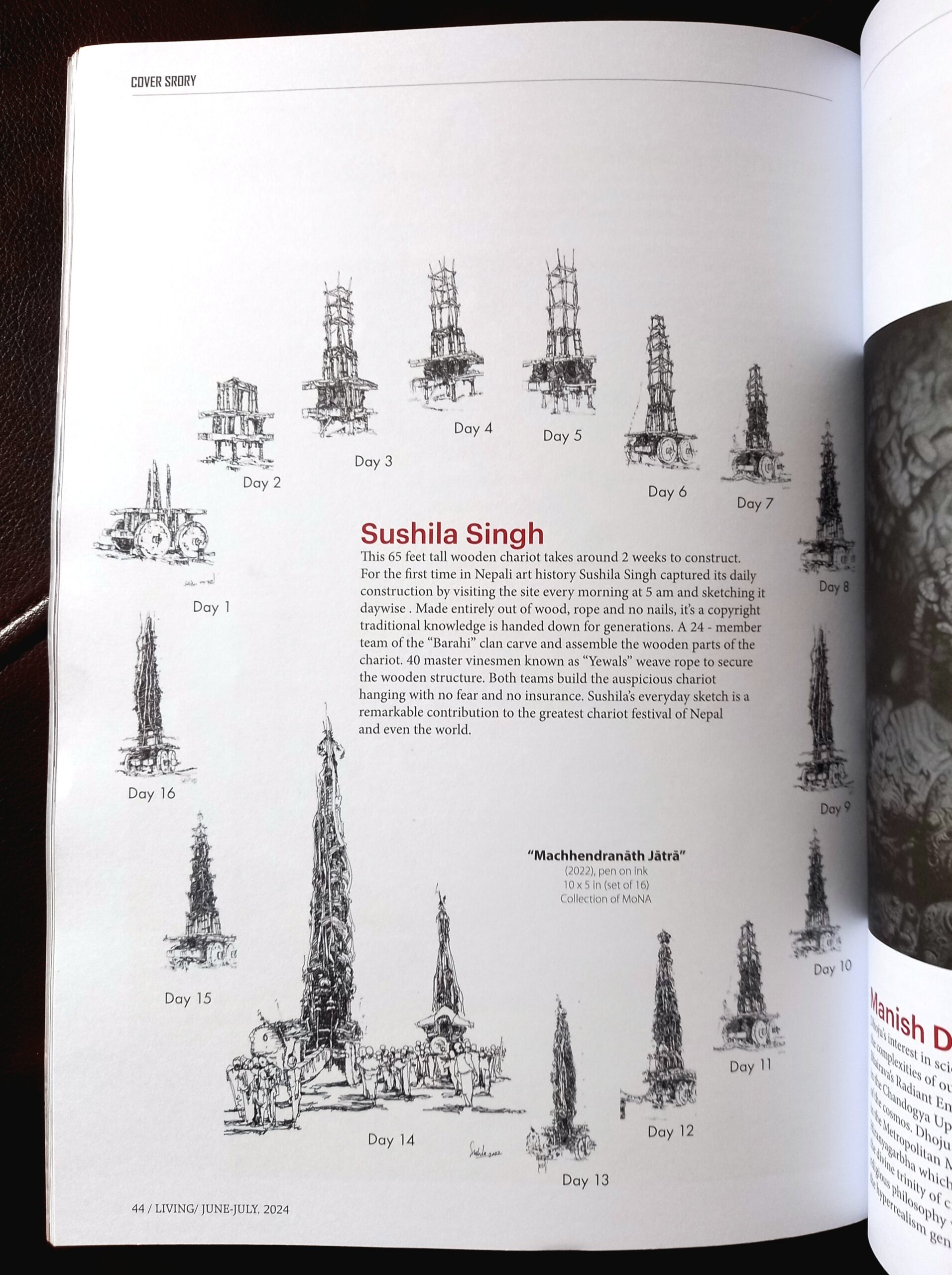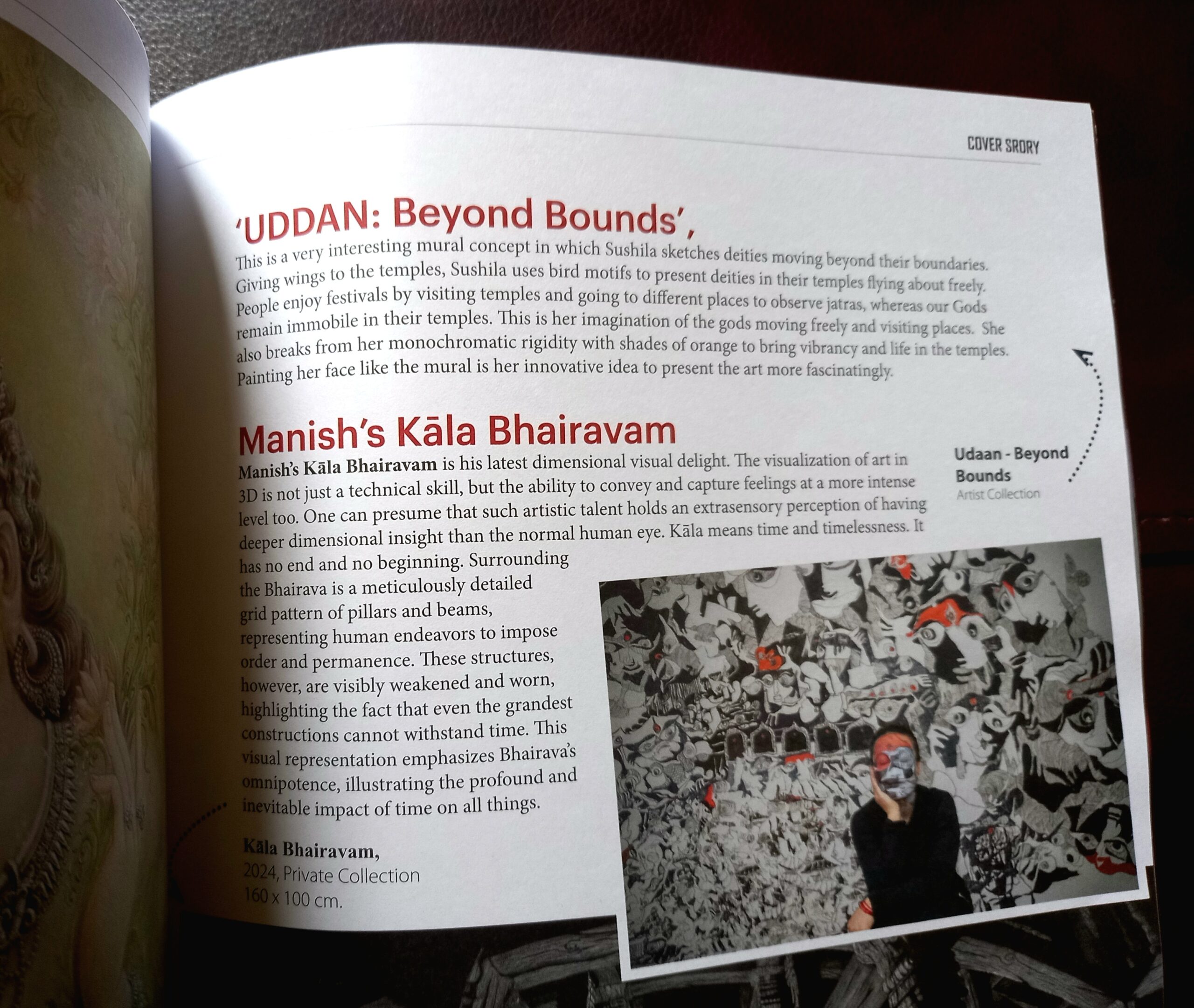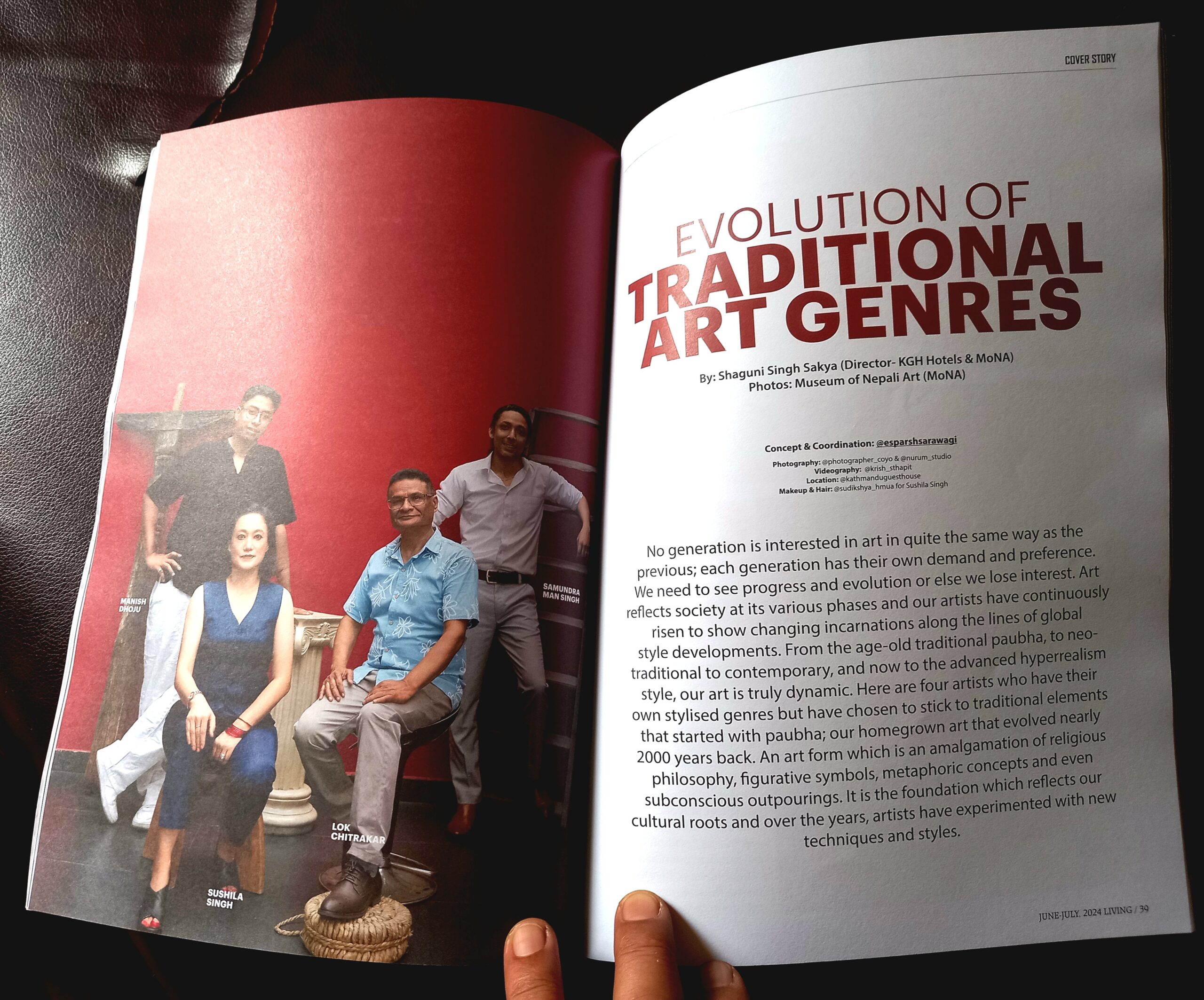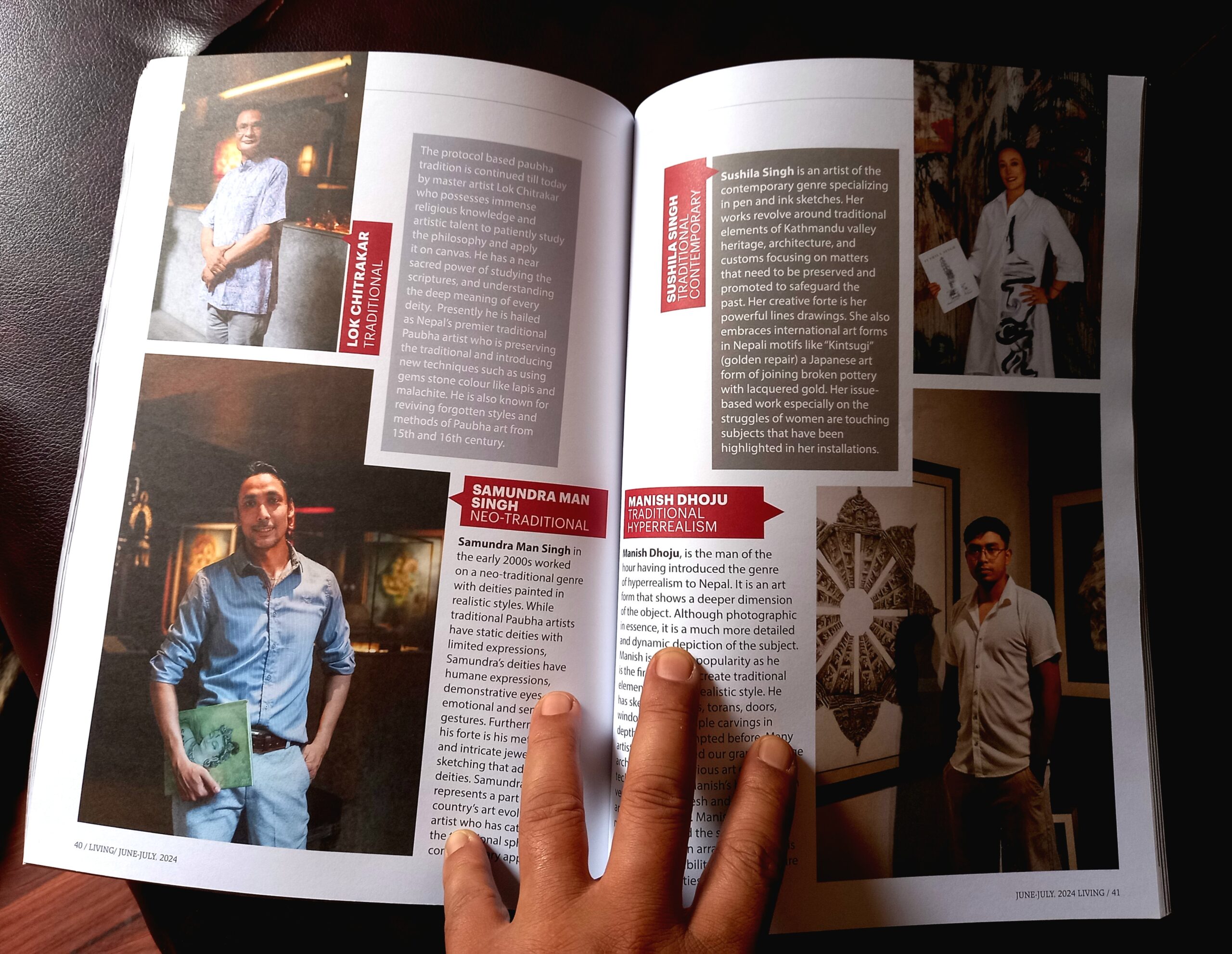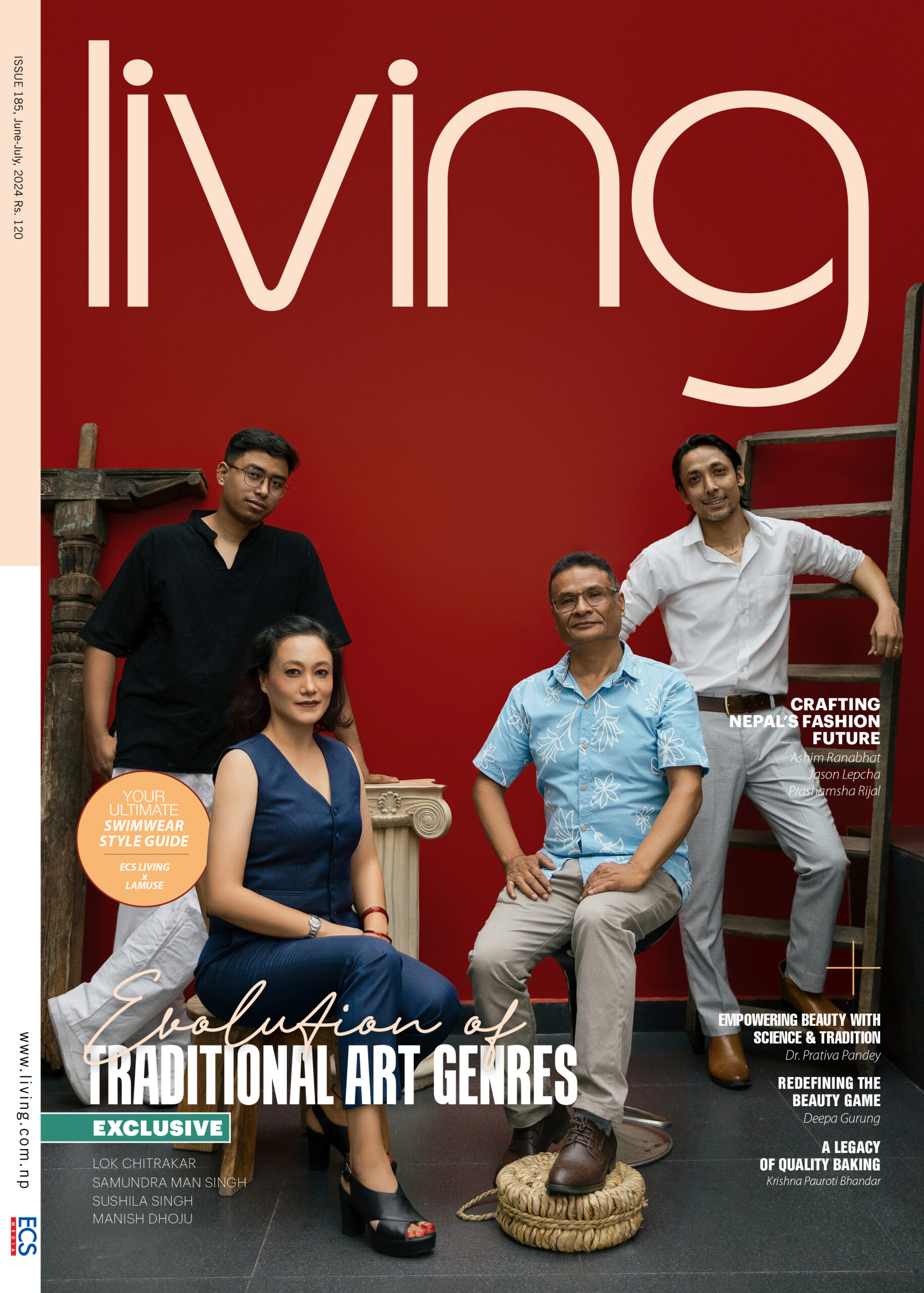
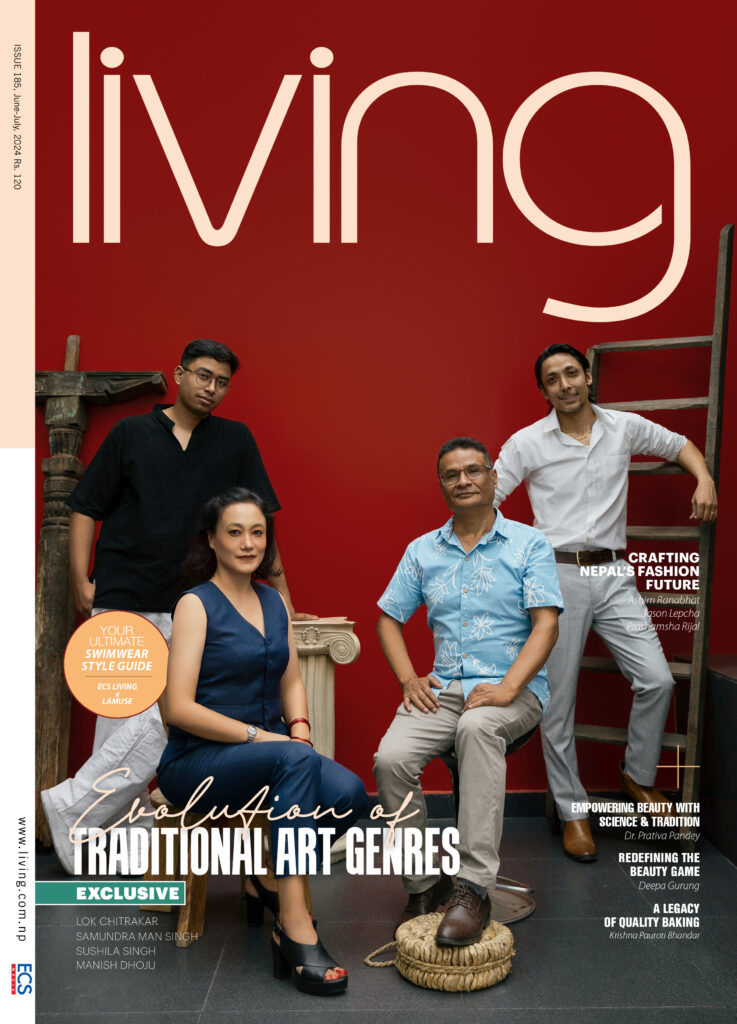
Evolution of Traditional Art Genres
By: Shaguni Singh Shakya (Director – KGH Hotels & MoNA)
Photos: Museum of Nepali Art (MoNA)
Concept & Coordination: @esparshsarawagi
Photography: @photographer_coyo & @nurum_studio
Videography: @krish_sthapit
Location: @kathmanduguesthouse
Makeup & Hair: @sudikshya_hmua for Sushila Singh
Published on ECS Living / 39, June – July 2024
No generation is interested in quite the same way as the previous; each generation has their own demand and preference. We need to see progress and evolution or else we lose interest. Art reflects society at its various phases and our artists have continuously risen to show changing incarnations along the lines of global style developments. From the age-old rational paubha, to neo traditional to contemporary, and now to the advanced hyperrealism style, our art is truly dynamic. Here are four artists who have their own stylised genres but have chosen to stick to traditional elements that started with paubha; our home-grown art that evolved nearly 2000 years back. An art form which is an amalgamation of religious philosophy, figurative symbols, metaphoric concepts and even subconscious outpourings. It is the foundation which reflects our cultural roots and over the years, artists have experimented with new techniques and styles.
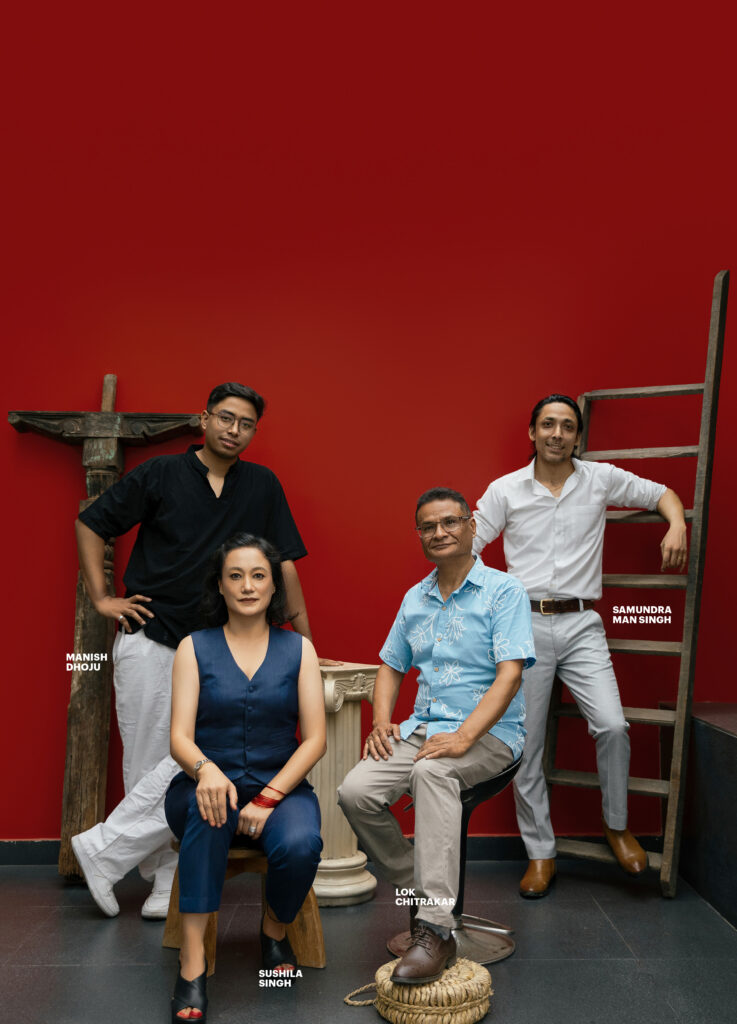
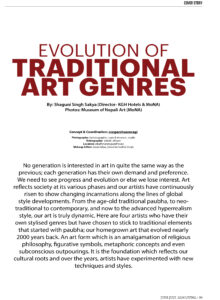
LOK CITRAKAR – TRADITIONAL
The protocol based paubha tradition is continued till today by master artist Lok Chitrakar who possesses immense religious knowledge and artistic talent to patiently study the philosophy and apply it on canvas. He has a near sacred power of studying the scriptures, and understanding the deep meaning of every deity. Presently he is hailed as Nepal’s premier traditional Paubha artist who is preserving the traditional and introducing new techniques such as using gems stone colour like lapis and malachite. He is also known for reviving forgotten styles and methods of Paubha art from 15th and 16th century.
SAMUNDRA MAN SINGH: NEO-TRADITIONAL
Samundra Man Singh in the early 2000s worked on a neo-traditional genre with deities painted in realistic styles. While traditional Paubha artist have static deities with limited expressions, Samundra’s deities have humane expressions, demonstrative eyes, and emotional and sensual gestures. Furthermore, his forte his meticulous and intricate jewellery sketching that adorn the deities. Samundra’s journey represents a part of the country’s art evolution – an artist who has catapulted the traditional sphere into contemporary appeal.
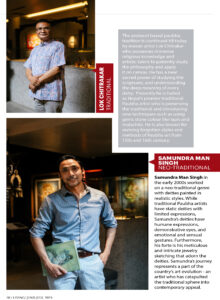
SUSHILA SINGH: TRADITIONAL CONTEMPORARY
Sushila Singh is an artist of the contemporary genre specializing in pen and ink sketches. Her works revolve around traditional elements of Kathmandu valley heritage, architecture, and customs focusing on matters that need to be preserved and promoted to safeguard the past. Her creative forte is her powerful lines drawings. She also embraces international art forms in Nepali motifs like “Kintsugi” (golden repair) a Japanese art form of joining broken pottery with lacquered gold. Her issue-based works especially on the struggles of women are touching subjects that have been highlighted in her installations.
MANISH DHOJU: TRADITIONAL HYPERREALISM
Manish Dhoju is the man of the hour having introduced the genre of hyperrealism to Nepal. It is an art form that shows a deeper dimension of the object. Although photographic in essence, it is a much detailed and dynamic depiction of the subject. Manish is gaining popularity as he is the first artist to create traditional elements in hyper realistic style. He has sketched struts, torans, doors, windows, and temple carving in depth never attempted before. Many artists have painted our grand heritage architecture in various art genres and techniques, but Manish’s hyperrealism versions give a fresh and futuristic artist approach. Manish sees the micro details and the sculpted work are enhanced in an array of lenses. This gives higher visibility to the miniature objects and deities carved.
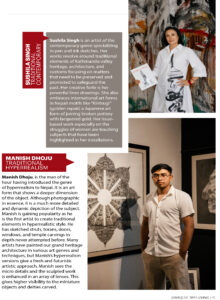
ART CLOSE TO THEIR HEART
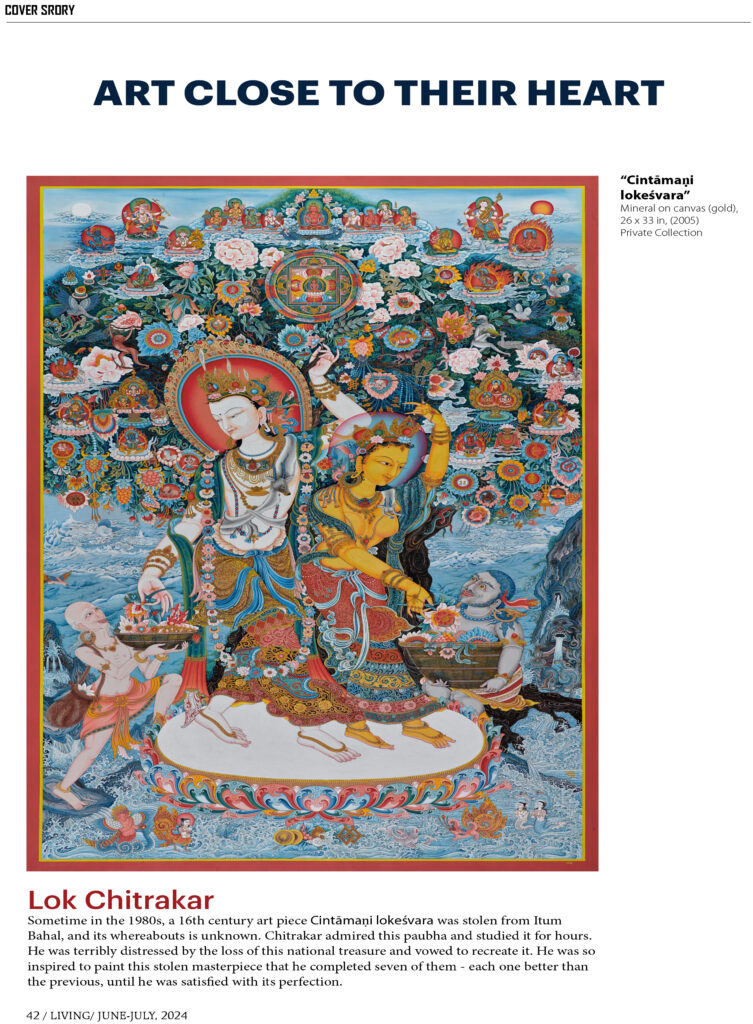
“Cintamani Lokesvara” Mineral on canvas (gold), 20 by 33 in, (2005) Private Collection
LOK CHITRAKAR
Sometime in the 1980s, a 16th century art piece Cintamani Lokesvara was stolen from Itum Bahal, and its whereabouts is unknown. Chitrakar admired this paubha and studied it for hours. He was terribly distressed by the loss of this national treasure and vowed to recreate it. He was so inspired to paint this stolen masterpiece that he completed seven of them – each one batter than the previous, until he was satisfied with its perfection.
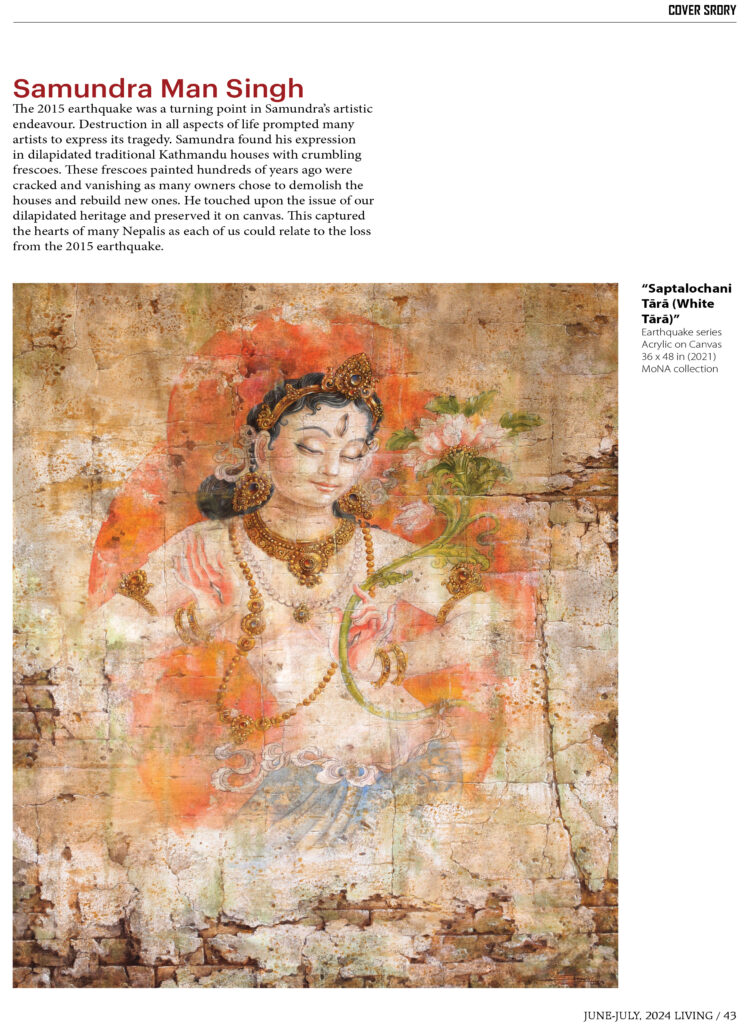
“Septalochani Tara (White Tara)” Earthquake series Acrylic on Canvas, 36 by 48 in (2021) MoNA collection)
SAMUNDRA MAN SINGH
The 2015 earthquake was a turning point in Samundra’s artistic endeavour. Destruction in all aspects of life prompted many artists to express its tragedy. Samundra found his expression in dilapidated traditional Kathmandu houses with crumbling frescoes. These frescoes painted hundreds of years ago were cracked and vanishing as many owners chose to demolish the houses and rebuild new ones. He touched upon the issue of our dilapidated heritage and preserved it on canvas. This captured the hearts of many Nepalis as each of us could relate to the loss from the 2015 earthquake.
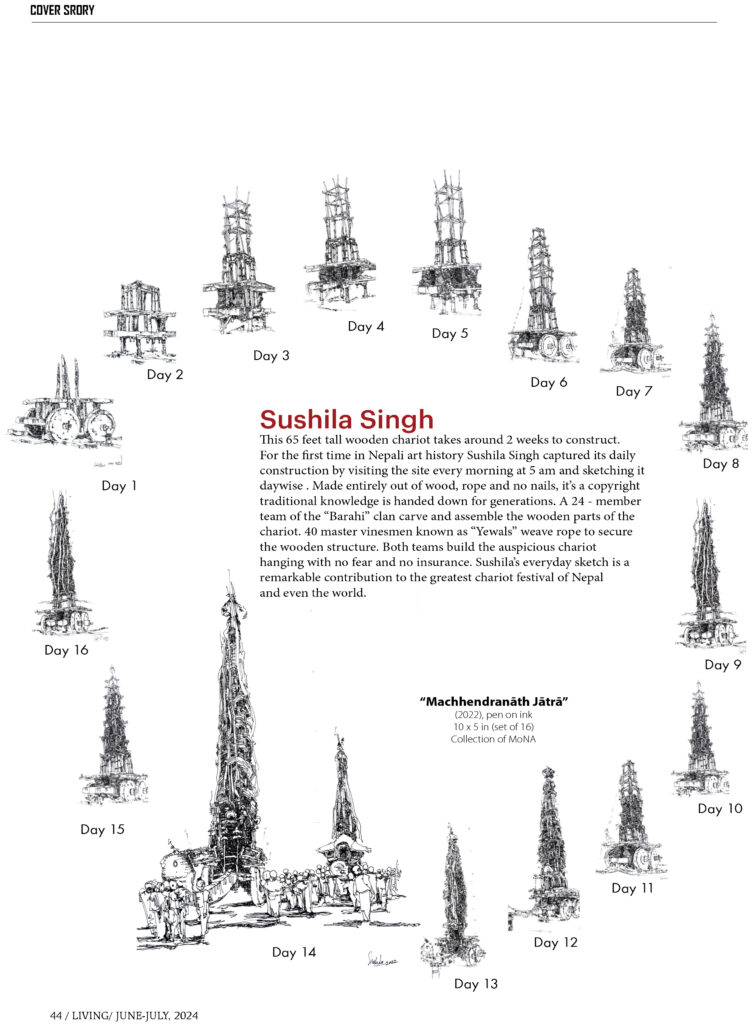
“Machhendranath Jatra”
Pen on in ink (2022), 10 by 14 in (set of 16)
Collection of MoNA
SUSHILA SINGH
This 65 feet tall wooden chariot takes around 2 weeks to construct. For the first time in Nepali art history Sushila Singh captured its daily construction by visiting the site every morning at 5 am and sketching it day wise. Made entirely out of wood, rope and no nails, it’s a copyright traditional knowledge is handed down for generations. A 24 – member team of the “Barahi” clan carve and assemble the wooden parts of the chariot. 40 master vines men known as “Yewals” weave rope to secure the wooden structure. Both teams build the auspicious chariot hanging with no fear and no insurance. Sushila’s everyday sketch is a remarkable contribution to the greatest chariot festival of Nepal and even the world.
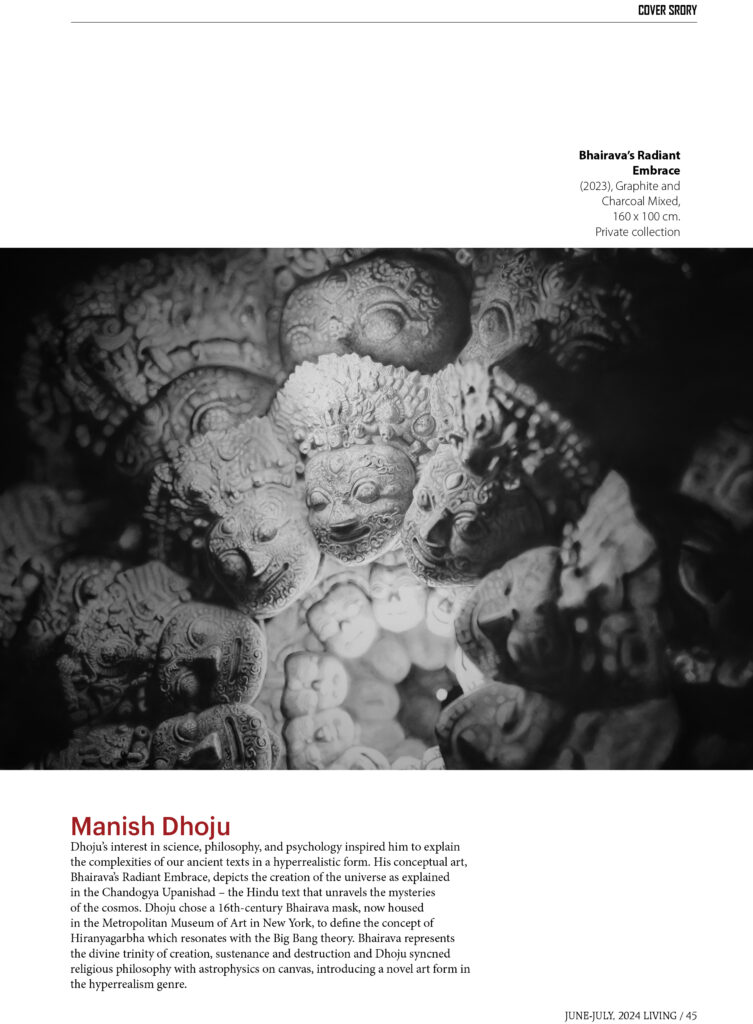
Bhairava’s Radiant Embrace
2023, Graphite and Charcoal Mixed, 160 by 100 cm. Private collection
MANISH DHOJU
Dhoju’s interest in science, philosophy, and psychology inspired him to explain the complexities of our ancient texts in a hyper realistic form. His conceptual art, Bhairava’s Radiant Embrace, depicts the creation of the universe as explained in the Chandogya Upanishad – the Hindu text that unravels the mysteries of the cosmos. Dhoju chose a 16th-century Bhairava mask, now housed in the Metropolitan of art in New York, to define the concept of Hiranyagarbha which resonates with the Big Bang theory. Bhairava represents the divine trinity of creation, sustenance and destruction and Dhoju synched religious philosophy with astrophysics on canvas, introducing a novel art form in the hyperrealism genre.
WHY YOUR ART SHOULD BE ACQUIRED?
Nepali artist by nature are very modest and they feel uncomfortable to speak about themselves. This seems to be an ingrained social behaviour from centuries of belief that making art is for the higher purpose of dedication to religion and not personal identity. Many traditional Nepali artists even today feel that “personal publicity” ruins the art of its integrity. A very h7umble eastern mentality unlike the artists of the West who focus a lot on personal identity, maximum marketing and publicity. Nevertheless, we now live in a global world and artists today are talking about themselves, yet none of them feel comfortable to talk on monetary value.
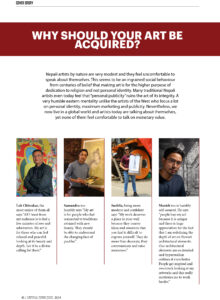
Lok Chitrakar, the most senior of them all says “All I want from m y audience is to feel a few minutes of awe and admiration. My art is for those who can feel relaxed and peaceful looking at its beauty and depth. Let it be a divine calling for them.”
Samundra too humbly says “My art is for people who feel connected to traditions retained with new beauty. They should be able to understand the changing face of paubha”
Sushila, being more modern and confident says “My work deserves a place in your wall because they convey ideas and emotions that you find it difficult to express yourself. The67 do communicate and raise awareness.”
Manish too is humbly self-assured. He says “people buy my art because it is unique and there is huge appreciation for the fact that I am redefining the depth of art on Newari architectural elements. Our architectural elements are so detailed and hyperrealism outlines it even better. People get inspired and awestruck looking at my artworks and this really motivates me to work harder.”
DISTINCT CONCEPTUAL MASTERPIECES
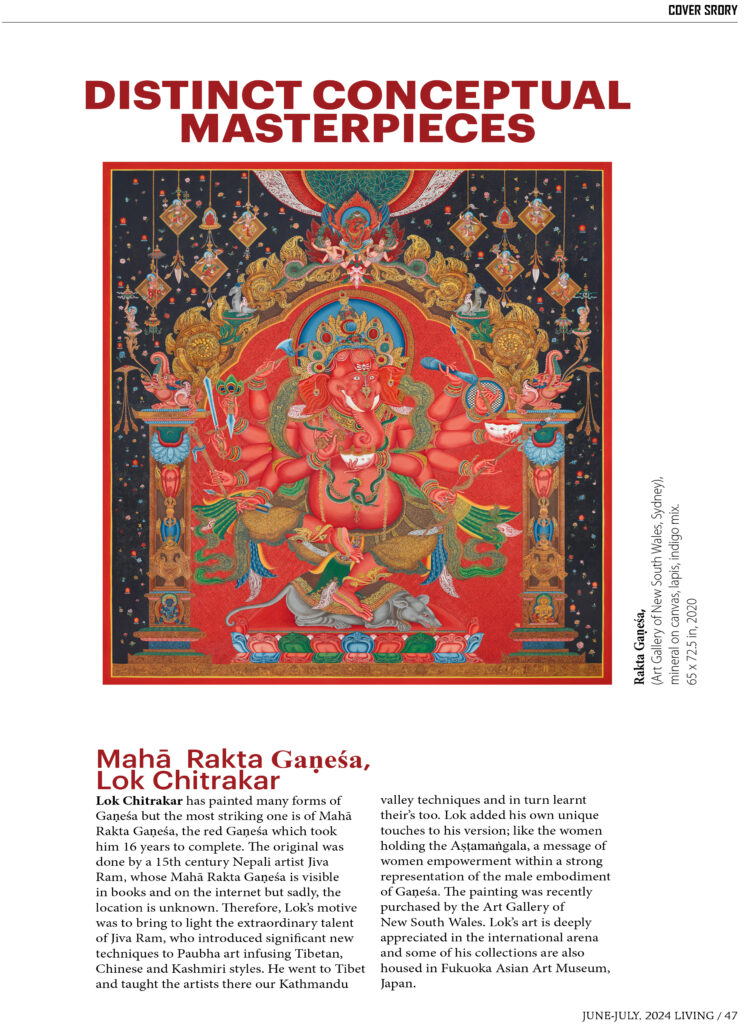
Rakta Ganesa, (Art Gallery of New South Wales, Sydney),
Mineral on canvas, lapis, indigo mix. 65 by 72 in, 2020
Maha Rakta Ganesa, Lok Chitrakar
Lok Chitrakar has painted many forms of Ganesa but the most striking one is of Maha Rakta Ganesa, the red Ganesa which took him 16 years to complete. The original was done by a 15th century Nepali artist Jiva Ram, whose Maha Rakta Ganesa is visible in books and on the internet but sadly, the location is unknown. Therefore, Lok’s motive was to bring the extraordinary talent of Jiva Ram, who introduced significant new techniques to Paubha art infusing Tibetan, Chinese and Kashmiri styles. He went to Tibet and taught the artists there our Kathmandu valley techniques and in turn learnt theirs too. Lok added his own unique touches to his version; like the women holding the Astamangala, a message of women empowerment within a strong representation of the male embodiment of Ganesa. The painting was re recently purchased by the art Gallery of New South Wales. Lok’s art is deeply appreciated in the international arena and some of his collections are also housed in Fukuoka Asian Art Museum, Japan.
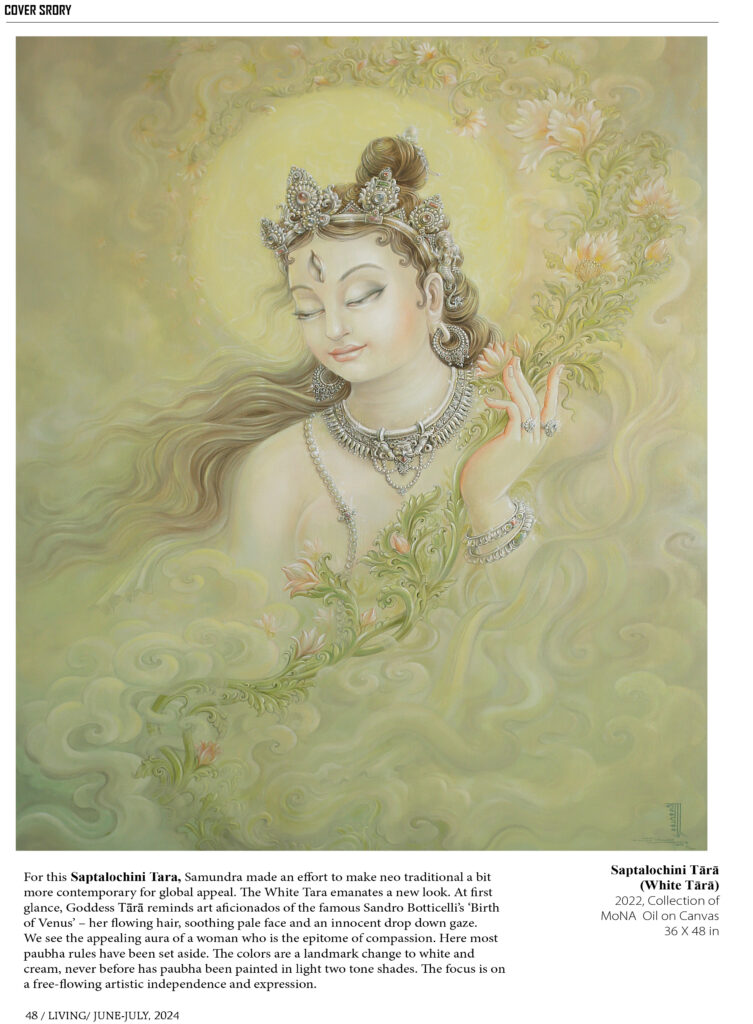
Saptalochini Tara, Samundra Man Shakya (White Tara)
2022, Collection of MoNA, Oil on Canvas, 36 by 48 in
For this Saptalochini Tara, Samundra made an effort to make neo traditional a bit more contemporary for global appeal. The White Tara emanates a new look. At first glance, Goddess Tara reminds art aficionados of the famous Sandro Botticelli’s Birth of Venus‘– her flowering hair, soothing pale face and an innocent drop down gaze. We see the appealing aura of a woman who is the epitome of compassion. Here most paubha rules have been set aisle. The colours are a landmark change to white and cream, never before has paubha been painted in light two tone shades. The focus is on a free00-flowing artistic independence and expression.
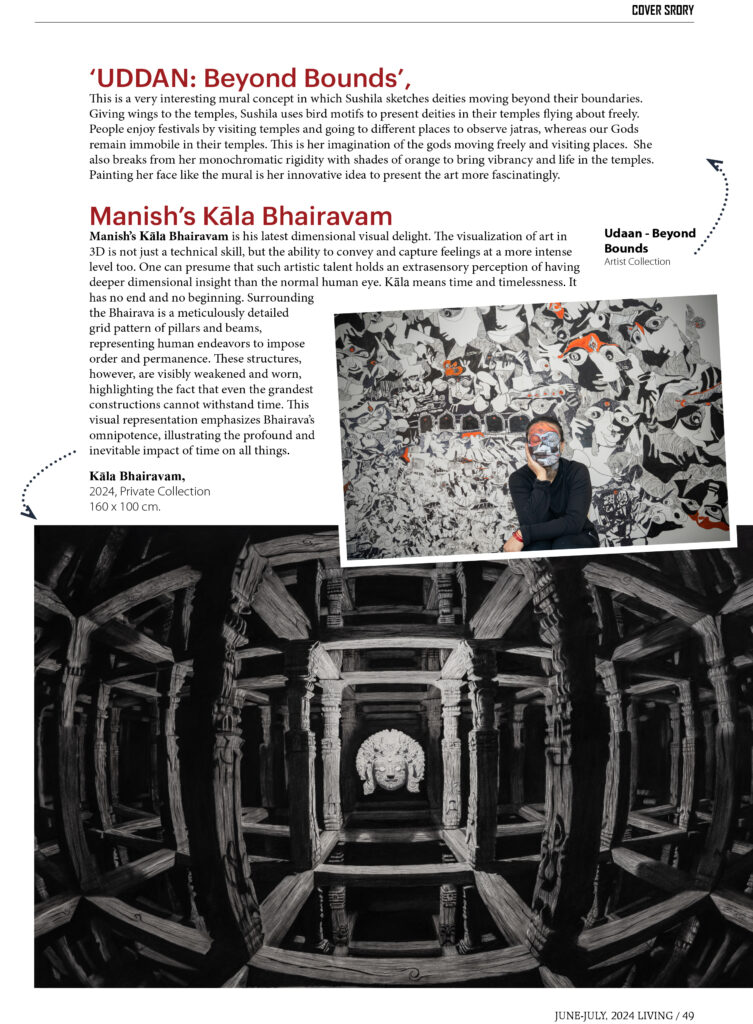
‘UDDAN: Beyond Bounds’, Sushila Singh, Artist Collection
Manish’s Kala Bhairavam
2024, Private Collection, 160 by 100 cm.
This is a very interesting mural concept in which Sushila sketches deities moving beyond their boundaries. Giving wings to the temples, Sushila uses bird motifs to present deities in their temples flying about freely. People enjoy festivals by visiting temples and going to different places to observe jatras, whereas our Gods reaming immobile in their temples. This is her imagination of the gods moving freely and visiting places. She also breaks from her monochromatic rigidity with shades of orange to bring vibrancy and life in the temples. Painting her face like the mural is her innovative idea to present the art more fascinatingly.
Manish’s Kala Bhairavam is his latest dimensional visual delight. The visualization of art in 3D is not just a technical skill, but the ability to convey and capture feelings at a more intense level too. One can presume that such artistic talent holds an extrasensory perception of having deeper dimensional insight that the normal human eye. Kala means time and timelessness. It has no end and no beginning. Surrounding the Bhairava is meticulously detailed grid pattern of pillars and beams, representing human endeavours to impose order and permanence. These structures, however, are visibly weakened and worn, highlighting the fact that even the grandest constructions cannot withstand time. This visual representation emphasizes Bhairava’s omnipotence, illustrating the profound and inevitable impact of time on all things.
